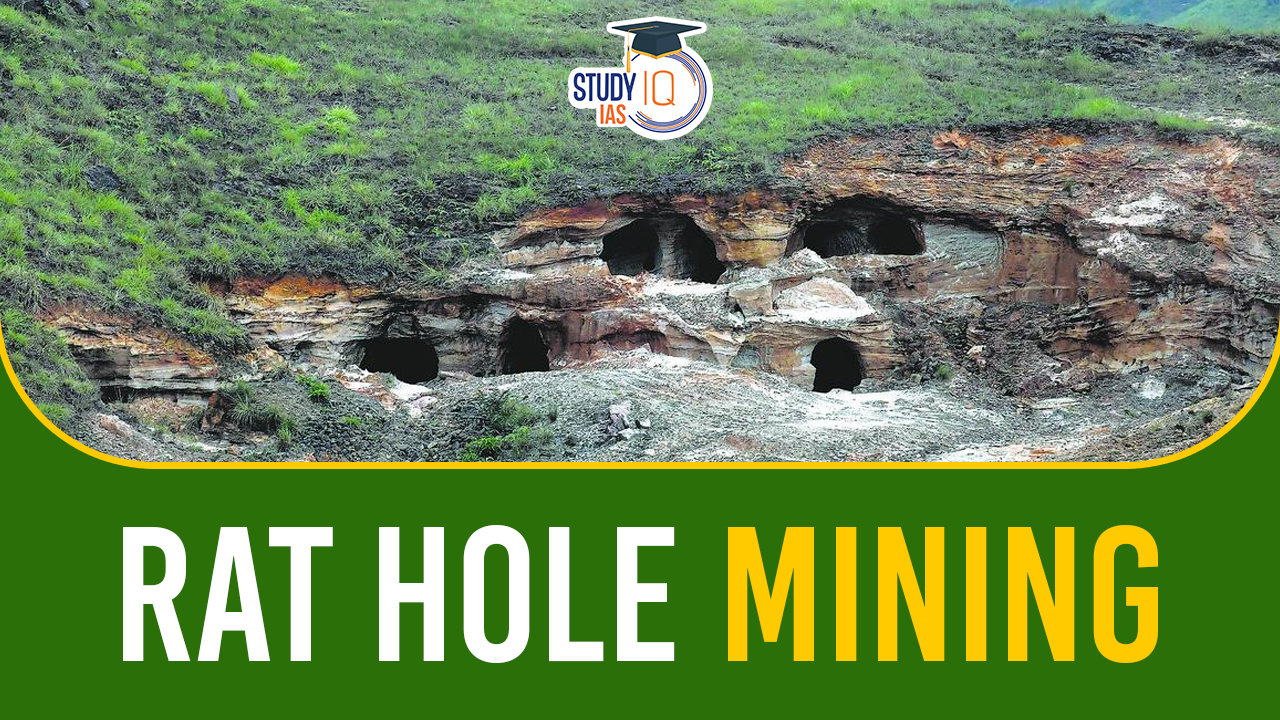Table of Contents
Context:
- 3 miners were confirmed dead and 6 remained trapped in a flooded coal “rat-hole” mine in Assam’s Dima Hasao district.
- Combined teams of the Indian Army and deep sea divers from the Indian Navy are assisting the operation.
What is Rat Hole Mining?
- It is a technique for coal extraction primarily used in Meghalaya, characterised by narrow, horizontal coal seams.
- It involves creating small pits like rat holes in the ground. These pits are just wide enough for a single miner to enter and reach the coal seams.
- Mining Process: Miners access the coal seams by descending into these pits with the aid of ropes or bamboo ladders, then manually mine the coal using basic tools like pickaxes and shovels.
- Ban: The National Green Tribunal (NGT) prohibited rat-hole mining in Meghalaya in 2014, because of multiple fatalities linked to flooding in the mines during the monsoon.
Rat Hole Mining Technique
Rat-hole mining is a controversial method of extracting coal from narrow, horizontal seams. The technique involves digging small pits, or “rat holes”, that are large enough for one person to enter and extract coal. Once the miners reach the coal seam, they make sideways tunnels to extract the coal. The coal is then dumped nearby and transported via highways. Rat-hole mining is prevalent in the Northeastern states of India, especially in Meghalaya. It was once popular in Meghalaya because coal deposits are not deep.
Types of Rat-Hole Mining
Side-Cutting Procedure
In this mining technique, narrow tunnels are meticulously excavated on the slopes of hills. Workers delve inside these tunnels until they locate the coal seam. Remarkably, the coal seam found in the hills of Meghalaya is notably thin, measuring less than 2 meters in most cases.
Box-Cutting Method
Contrastingly, the box-cutting method involves the creation of a rectangular opening, varying in size from 10 to 100 sqm. Through this opening, a vertical pit is meticulously dug to depths ranging from 100 to 400 feet. Once the coal seam is identified, workers proceed to carve rat-hole-sized tunnels horizontally, providing a pathway for the extraction of coal.
Rat Hole Mining in India
Rat Hole Mining in India, notably prevalent in Meghalaya, involves illegally excavating coal through narrow, hazardous tunnels resembling rat holes. Lacking proper regulations, this primitive method raises environmental concerns, including deforestation and water pollution. Safety issues, such as accidents and fatalities, further underscore its risks. Despite a ban imposed by the National Green Tribunal in 2014 and reinforced in 2015, enforcement remains a challenge, necessitating urgent attention to safeguard both the environment and the well-being of workers.
How Banned Rat-Hole Mining Saved India’s Trapped Workers?
In India, state officials enlisted the help of “rat-hole” miners to rescue 41 workers trapped in a tunnel after a collapse. The miners were adept at navigating tight spaces and manually clearing debris. They worked in two teams of three, with one person drilling, one collecting debris, and one pushing the debris out of the pipe. After 17 days, the workers were successfully pulled out.
“Rat-hole” mining is a banned method of manual coal extraction that involves digging narrow, vertical shafts into the ground. The name comes from the resemblance to rats digging pits. The pits are just big enough for workers to descend using ropes or bamboo ladders to extract coal. The practice became illegal in the 1970s.
Why was Rat-Hole Mining Banned?
In 2014, the National Green Tribunal (NGT) instituted a ban on rat-hole mining, reiterating the prohibition in 2015. The NGT highlighted numerous instances where this mining method, particularly prevalent in Meghalaya, led to fatal consequences during the rainy season due to water flooding into mining areas. Subsequently, the Meghalaya state government appealed the NGT’s order, seeking judicial review, with the matter eventually reaching the Supreme Court.
| Uttarkashi Tunnel Collapse Incident |
| The Uttarkashi Tunnel Collapse incident unfolded as a challenging rescue mission lasting seventeen days, where 41 workers were trapped inside the collapsed Silkyara tunnel in Uttarkashi. The rescue operation involved drilling through a 60-meter stretch of rubble, with National Disaster Response Force (NDRF) personnel using a steel chute for extraction.
Various methods were employed, including vertical drilling, auger mining, and ultimately resorting to the expertise of ‘rat miners’ to complete the drilling process successfully. The incident drew attention to the hazardous conditions in certain mining practices and the complexities involved in rescue operations. |
Environmental and Safety Concerns Related to Rat Hole Mining
Rat hole mining presents substantial risks to both safety and the environment. These mines operate without adequate regulation, neglecting crucial safety measures like proper ventilation, structural support, and safety gear for workers. Furthermore, the mining process contributes to issues such as land degradation, deforestation, and water pollution.
Criticism of this mining method stems from its perilous working conditions, environmental harm, and frequent accidents resulting in injuries and fatalities. Despite regulatory efforts to control or prohibit such practices, they persist due to economic factors and the lack of viable alternative livelihoods for the local population.
Rat Hole Mining UPSC
Rat Hole Mining, notably practiced in Meghalaya, involves extracting coal through narrow, hazardous tunnels. These makeshift mines lack regulations, posing serious safety risks due to inadequate ventilation, structural support, and safety gear for workers. Beyond endangering lives, this method contributes to environmental degradation, including deforestation and water pollution. Despite bans and criticisms, economic factors and the absence of alternative livelihoods often perpetuate the persistence of rat hole mining, highlighting the ongoing challenges in curbing this hazardous practice.


 Rare Earth Elements, Metals, Magnets, Ap...
Rare Earth Elements, Metals, Magnets, Ap...
 Places in News for UPSC 2025 for Prelims...
Places in News for UPSC 2025 for Prelims...
 Indian Continental Plate is Splitting Ap...
Indian Continental Plate is Splitting Ap...





















